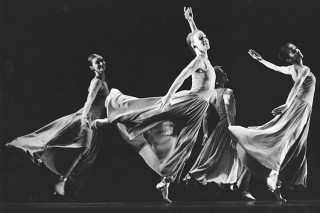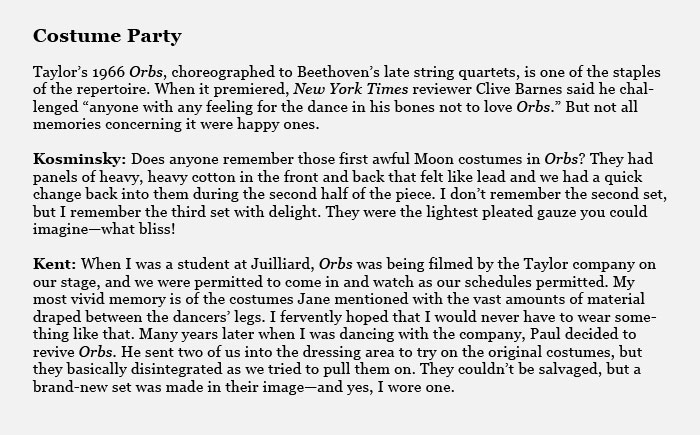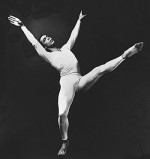Title
Subhead

This photo from around 1978 of Taylor’s Cloven Kingdom shows, from left, Monica Morris, faculty member and alum Linda Kent, Ruth Andrien, and former faculty member Carolyn Adams.
(Photo by Susan Cook) More Photos »In anticipation of the 60th anniversary of Paul Taylor Dance Company, two members of the dance faculty reminisced about dancing with one of Juilliard’s earliest dance alums: Paul Taylor (’53, dance; honorary degree ’88). His company will be in residence at Lincoln Center’s David H. Koch Theater from March 12 to 30. Jane Kosminsky, who danced with the company from 1965 to 1971, joined the Juilliard faculty in 1971. Linda Kent (B.S. ’68, dance) danced with Taylor from 1975 to 1989 and joined the Juilliard faculty in 1984.
Body
Jane Kosminsky
In December 1965, the Paul Taylor Dance Company was about to go to Paris for three weeks—but one dancer was pregnant, another had just broken her toe, and Paul needed an extra dancer immediately—so he invited me to join them. I was going to Paris! Not only that, I was going to be paid to go to Paris! I had under a month to learn seven works in the repertory (Aureole, 3 Epitaphs, Junction, Post Meridian, Scudorama, Party Mix, From Sea to Shining Sea). There was only one small problem: I was studying for my last set of finals at City College at the same time.
When I got home from rehearsal, I didn’t know whether to pick up my physics book, mend costumes (yes, we did that then), or try to remember the steps I had learned that day. On Christmas Day, I read two novels by Jane Austen. Don’t ask me what they were. And then, on New Year’s Day, there was a subway strike. School was cancelled. Finals were cancelled. How was I going to graduate?
Finally, on the day of departure, the strike was over. I took exams from 8 in the morning to 4 in the afternoon and then I was picked up by Dorothy, company manager Charlie Reinhart’s associate, driven home to collect my bag, and taken straight to the airport. And there was wonderful Nathan Clark seeing us off with magnum of very good French Champagne—bonne chance—we were off!
A few years later, I had one of the richest dance experiences ever. It was May 1969, and I had had surgery on my left knee. I missed the New York season. I missed dancing the premier of Private Domain with my beautiful new solo in it. And I missed the South American tour. I was devastated and frightened. What if I could never dance again? These were the pre-arthroscopy years: all the cartilage was removed and I was left with bone on bone and a slightly collapsed leg. My orthopedist suggested that that I might consider another career, and while I’m very polite, I’m also very stubborn. I didn’t listen.
Paul, in his wisdom, handed me the keys to the studio. “Sweetie, put yourself back into your roles while we are gone,” he said. Just that—he didn’t fire me and he didn’t doubt me. Every day I went to the studio and worked for three hours. I had energy but very little muscle, and my stamina was gone. I had to begin at the beginning and explore what it actually took to dance.
I started with just marking (indicating) the movement. Could I make it look full if I did so little? How much more muscle would it actually take to keep the dancing physical and dynamic? What if I just focused on my breath and made that the impetus for movement? Did that make it easier of harder? What if I pretended that my center was very, very narrow like a thread? It was certainly easier to move a thread than a three-dimensional body.
What are the tools we need to become a better dancer, a better communicator, a better artist? How can we solve problems in movement, in alignment, in art, and in life? I experimented endlessly. At the end of the day, I would lie on the floor and stretch. It was quiet, peaceful, and wonderful. I felt complete. It took six months, and Paul did not push. He was utterly patient. When the company got back into rehearsal for the winter tour, I was ready, and rejoined the company. He had given me the gift of myself.
Linda Kent
It isn’t rare to run into dancers who, years later, have never forgotten the experience of dancing with Paul Taylor Dance Company. One thrill of my many restagings at Juilliard has been the opportunity to work with Juilliard musicians and conductors and have the dancers revel in the synergy of live music.
I’m not sure exactly what the musical education for dance students was like when Paul Taylor was a student at Juilliard. When I was a student, it was a very inclusive and intensive four-year program culminating in an oral exam. We even studied piano for a year—I remember crying through many a frustrating practice session—controlling those 10 fingers was so much more challenging than the most intricate dance moves.
In the cafeteria I would sit at the musicians’ table when I wanted a break from the usual dancers’ laments. I remember many pronouncements and debates about what music could and could not be used for choreography. Future conductor Leonard Slatkin (B.M. ’67, orchestral conducting) was adamant about no Bach or Beethoven. But Paul Taylor was never inhibited by those arguments and created so many landmark works to music by Beethoven, Handel, Boyce, Corelli, and Stravinsky as well as contemporary composers. When dance has been wed to music, it forever resonates in your body. I remember sitting in a doctor’s office when familiar music came on and twitching in my seat until I realized it was a duet section from Arden Court, which was set to music by Baroque composer William Boyce. And one time, some of us met to have a leisurely lunch during a week off from the company—that’s a rare opportunity because the rehearsing and performing schedule is so busy. But the restaurant’s classical music soundscape wasn’t so relaxing: sections of three of Paul’s different dances serenaded us!
It is always a joy to be part of Paul Taylor’s creative process. He has just finished his 140th—or is it 141st?—dance to be presented across the plaza [at the Koch Theater] in March. It has been my honor to be entrusted with restaging many of these works on companies and at conservatories and universities around the world for more than 30 years. It is a unique challenge and opportunity to share not only the work of a master choreographer but the joy and fulfillment inherent in performing his work.








